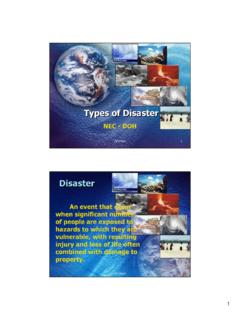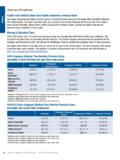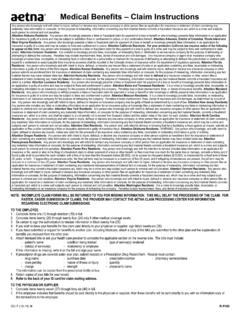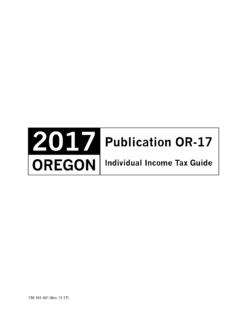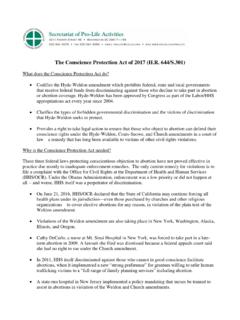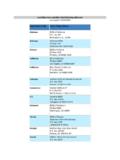Transcription of Emergency Response Plan
1 Emergency Response plan Food Emergency Template Version National Association of State Departments of Agriculture PREFACE. This document is part of an effort to develop a seamless system of food defense from local, state and federal perspectives. Overall, it addresses the goal of enhancing the protection of the United States agricultural industry and food security through the increased prevention, detection, Response and recovery planning. In February 2003, President Bush issued Homeland Security Presidential Directive 5. (HSPD-5), which describes how the federal departments will manage domestic incidents by establishing a single, comprehensive national incident management system. HSPD-5. directed the development of a National Response Framwork (NRF) to integrate federal domestic prevention, preparedness, Response , and recovery plans into one all-discipline, all-hazards plan . This framework document describes how the government and private sector will coordinate activities to respond to and recover from a domestic incident.
2 In July 2004, two supplemental documents (annexes) were issued that address food and agriculture: Emergency Support Function #8 addresses public health and medical care, including food under the regulatory oversight of the FDA. Emergency Support Function #11 addresses issues related to nutrition, food safety, animal and plant disease outbreaks. In September 2004, the National Association of State Departments of Agriculture (NASDA) signed a cooperative agreement with USDA's Food Safety Inspection Service (FSIS), the Food and Drug Administration (FDA), and the Department of Homeland Security (DHS) to develop best practices and guidelines for state and local Emergency Response efforts for incidents involving the nation's food supply. This document was designed to help states develop Response plans that dovetail with the federal Response protocols outlined in the National Response Framework (NRF) and associated annexes described above. In October 2004, NASDA organized a workgroup to support and implement the scope and objectives of the cooperative agreement.
3 Workgroup members included representatives from federal agencies, state agriculture departments, state health agencies and NASDA's affiliate organization, the Association of Food and Drug Officials (AFDO). During the period from November 2004 to April 2005, the workgroup and project contractor (SES, Inc.) completed several tasks: 1. Gathered survey information on state Emergency Response systems and how food and agricultural safety and security emergencies will be handled within the various states;. 2. Collected and inventoried all existing Emergency Response plans and exercises relevant to the food production chain, including crop and livestock plans, which were used to consider pre-harvest food defense issues. In addition, it was expected that future planning work would be focused on these areas as well;. 3. Reviewed and evaluated the state Emergency Response plan data for commonalities, differences, potential conflict, best practices, and gaps; and, 4. Created a database with all survey information and analysis of state Emergency Response plans.
4 02/09/2006 Prepared by SES, Inc. PREFACE. In April 2005, the workgroup began developing an Emergency Response plan template that states could use as a tool for developing their own Response plans. The template was based on the information and Response plans collected from the states. It was designed to provide seamless coordination between states and localities and the NRF. In July 2005, the food template was distributed to a panel of experts for additional review. These experts were recommended by the workgroup and represented various federal, state and local agencies and agricultural stakeholders. Their comments were incorporated into the template in late August 2005. In September 2005, the workgroup selected three states to evaluate or test the food template Illinois, Michigan and Oregon. These states were chosen because they represented a range of existing food regulatory frameworks (within agriculture or public health agencies) and reflected both urban and rural areas. The purpose of this evaluation was to: 1.
5 Determine if states could utilize the template to develop their own Emergency Response plan ;. 2. Identify any gaps in the template; and, 3. Gather additional input on the template. Many other states volunteered for the evaluation activity because they informed NASDA. that it would assist states with development of either a stand-alone plan for responding to a food-related Emergency or an addendum to an existing all-hazard state Emergency Response plan . Feedback from the three state evaluations was positive and the comments gathered during this activity have been incorporated into the food template. In December 2005 and January 2006, the workgroup conducted a final review and finalized the document. The following chart shows how the food template will be coordinated with the federal activities. 02/09/2006 Prepared by SES, Inc. PREFACE. National Response Framework (NRF). (HSPD-5). Describes how the government and private sector will coordinate activities to respond and recover from a domestic incident affecting any sector.
6 Food & Agriculture - Support Functions of the NRF. Outlines federal Response efforts for the food and agriculture sector. Emergency Support Function #11 Addresses issues related to nutrition, food safety, animal and plant disease outbreaks. Emergency Support Function #8 - Addresses issues related to public health, including food. Food & Agriculture - NRF Incident Annex To be developed by federal partners to guide specific federal Response protocols. State Food State Plant State Animal Response Plans Response Plans Response Plans 02/09/2006 Prepared by SES, Inc. PREFACE. This document is part of an effort to develop a seamless system of food defense from local, state and federal perspectives. Overall, it addresses the goal of enhancing the protection of the United States agricultural industry and food security through the increased prevention, detection, Response and recovery planning. In February 2003, President Bush issued Homeland Security Presidential Directive 5. (HSPD-5), which describes how the federal departments will manage domestic incidents by establishing a single, comprehensive national incident management system.
7 HSPD-5. directed the development of a National Response Framwork (NRF) to integrate federal domestic prevention, preparedness, Response , and recovery plans into one all-discipline, all-hazards plan . This framework document describes how the government and private sector will coordinate activities to respond to and recover from a domestic incident. In July 2004, two supplemental documents (annexes) were issued that address food and agriculture: Emergency Support Function #8 addresses public health and medical care, including food under the regulatory oversight of the FDA. Emergency Support Function #11 addresses issues related to nutrition, food safety, animal and plant disease outbreaks. In September 2004, the National Association of State Departments of Agriculture (NASDA) signed a cooperative agreement with USDA's Food Safety Inspection Service (FSIS), the Food and Drug Administration (FDA), and the Department of Homeland Security (DHS) to develop best practices and guidelines for state and local Emergency Response efforts for incidents involving the nation's food supply.
8 This document was designed to help states develop Response plans that dovetail with the federal Response protocols outlined in the National Response Framework (NRF) and associated annexes described above. In October 2004, NASDA organized a workgroup to support and implement the scope and objectives of the cooperative agreement. Workgroup members included representatives from federal agencies, state agriculture departments, state health agencies and NASDA's affiliate organization, the Association of Food and Drug Officials (AFDO). During the period from November 2004 to April 2005, the workgroup and project contractor (SES, Inc.) completed several tasks: 1. Gathered survey information on state Emergency Response systems and how food and agricultural safety and security emergencies will be handled within the various states;. 2. Collected and inventoried all existing Emergency Response plans and exercises relevant to the food production chain, including crop and livestock plans, which were used to consider pre-harvest food defense issues.
9 In addition, it was expected that future planning work would be focused on these areas as well;. 3. Reviewed and evaluated the state Emergency Response plan data for commonalities, differences, potential conflict, best practices, and gaps; and, 4. Created a database with all survey information and analysis of state Emergency Response plans. 02/09/2006 Prepared by SES, Inc. TABLE OF CONTENTS. X. FEDERAL ROLES AND RESPONSIBILITIES .. 24. XI. TRIBAL 24. XII. LOCAL GOVERNMENT .. 25. Emergency 25. Emergency Management .. 25. Local Health Departments .. 25. Local Hospitals .. 26. Local Law 26. Local Government .. 26. Volunteer Organizations Assisting in Disasters .. 26. XIII. PRIVATE SECTOR .. 26. Local Hospitals .. 28. XIV. AUTHORITIES AND REFERENCES .. 28. XV. RECOVERY .. 29. XVI. TRAINING AND EXERCISES .. 29. XVII. FUNDING AND 30. XVIII. plan UPDATES .. 31. APPENDICES. APPENDIX A PLANNING CONSIDERATIONS. APPENDIX B EXAMPLE TEXT FROM STATE PLANS AND CONTENT. SUGGESTIONS. APPENDIX C CONTACT LIST.
10 APPENDIX D ROLES AND RESPONSIBILITIES MATRIX. APPENDIX E DHS DIRECTORATE SUPPORT MATRIX. 02/09/2006 ii Prepared by SES, Inc. Food Emergency plan Template EXPLANATION OF ACRONYMS. APHIS Animal and Plant Health Inspection Service (of USDA). BTS Border Transportation and Security Directorate CDC Centers for Disease Control and Prevention DA Department of Agriculture DHS Department of Homeland Security DHHS Department of Health and Human Services EFORS Electronic Food-borne Outbreak Reporting System EMAC Emergency Management Assistance Compact EPA Environmental Protection Agency EP&R Emergency Preparedness and Response Directorate EOC Emergency Operations Center FBI Federal Bureau of Investigation FDA Food and Drug Administration FEMA Federal Emergency Management Agency FERN Food Emergency Response Network FERP Food Emergency Response plan FSIS Food Safety and Inspection Service HD Health Department HSPD Homeland Security Presidential Directive IAIP Information Analysis and Infrastructure Protection IC Incident Command ICLN Integrated Consortium of Laboratory Networks ICS Incident Command System JFO Joint Field Office JIC Joint Information Center JIS Joint Information System JOC Joint Operations Center LEOP Local

